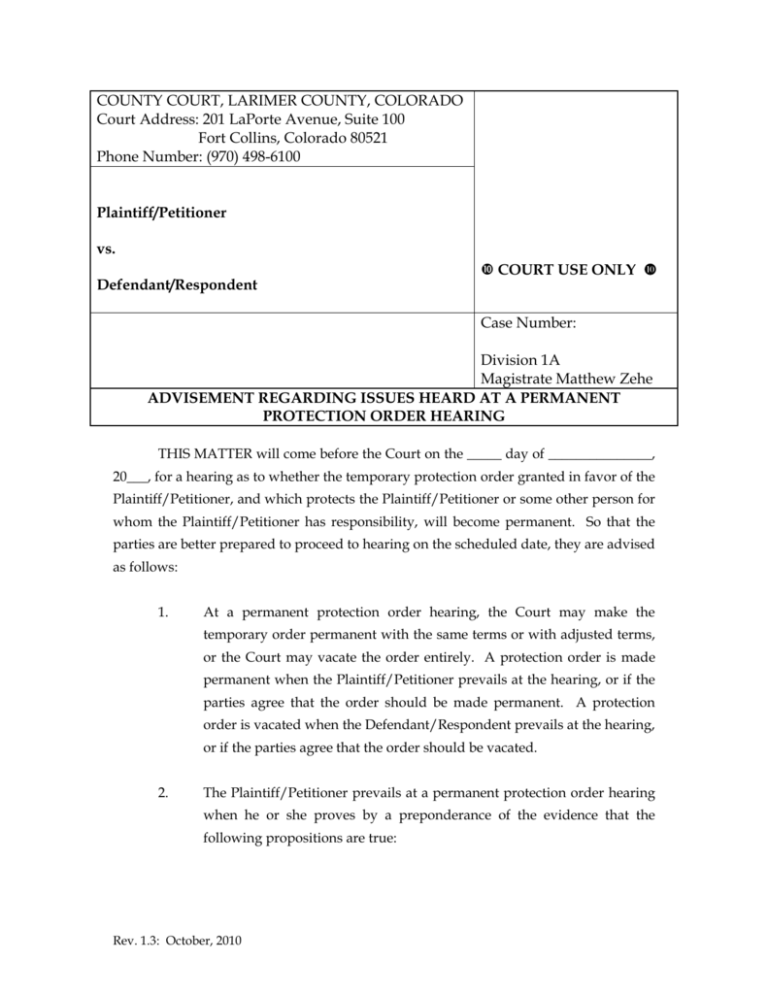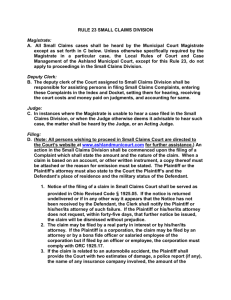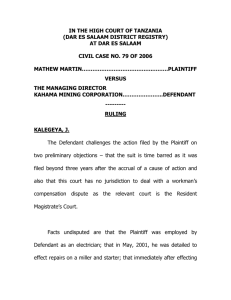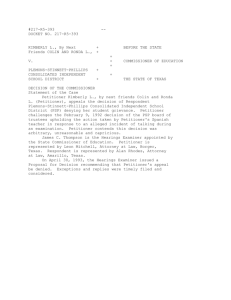Advisement Regarding Issues Heard at a Permanent Protection
advertisement

COUNTY COURT, LARIMER COUNTY, COLORADO Court Address: 201 LaPorte Avenue, Suite 100 Fort Collins, Colorado 80521 Phone Number: (970) 498-6100 Plaintiff/Petitioner vs. Defendant/Respondent COURT USE ONLY Case Number: Division 1A Magistrate Matthew Zehe ADVISEMENT REGARDING ISSUES HEARD AT A PERMANENT PROTECTION ORDER HEARING THIS MATTER will come before the Court on the _____ day of _______________, 20___, for a hearing as to whether the temporary protection order granted in favor of the Plaintiff/Petitioner, and which protects the Plaintiff/Petitioner or some other person for whom the Plaintiff/Petitioner has responsibility, will become permanent. So that the parties are better prepared to proceed to hearing on the scheduled date, they are advised as follows: 1. At a permanent protection order hearing, the Court may make the temporary order permanent with the same terms or with adjusted terms, or the Court may vacate the order entirely. A protection order is made permanent when the Plaintiff/Petitioner prevails at the hearing, or if the parties agree that the order should be made permanent. A protection order is vacated when the Defendant/Respondent prevails at the hearing, or if the parties agree that the order should be vacated. 2. The Plaintiff/Petitioner prevails at a permanent protection order hearing when he or she proves by a preponderance of the evidence that the following propositions are true: Rev. 1.3: October, 2010 a. The Defendant/Respondent has engaged in behavior or caused events to occur that has, in the past, placed the protected party at risk of imminent danger, AND b. The Defendant/Respondent is likely to continue to behave or cause events to occur that place the protected party at risk of imminent danger if the protection order is not made permanent. 3. “A preponderance of the evidence” means that the Plaintiff/Petitioner must present enough evidence to show that it is more likely than not that the two propositions above are both true. 4. At the hearing, the Court may begin the proceedings by asking the Defendant/Respondent whether he or she admits or denies the allegations made in the complaint. If the Defendant/Respondent disputes the allegations in the complaint, then the Plaintiff/Petitioner presents the evidence Defendant/Respondent he may, or she at has the available. conclusion The of the Plaintiff/Petitioner’s evidence, present evidence that contradicts the Plaintiff/Petitioner’s position or that tends to show that the protection order should not be made permanent. The Court may adjust this procedure to expedite the proceeding. 5. Evidence acceptable to the court includes, but is not limited to, the following categories: a. The live testimony of witnesses or parties to the action. Written witness statements or affidavits will NOT be accepted in lieu of live testimony. b. Official records for a business or government agency that are routinely kept in the normal course of that business’s or agency’s activities. Examples include medical records, police reports, bills for cellular service, reports generated by a security service, etc. Copies of all documents a person wishes the Court to consider should be prepared for distribution to the Court and to the opposing party. Rev. 1.3: October, 2010 c. Evidence that preserves or records the activities of a party or witness. Examples include photographs, email or text communications, messages left on answering machines or voice mail, etc. It is the responsibility of the party presenting this evidence to supply the equipment, such as a CD or tape player, necessary for the Court to hear or view such evidence. The Court cannot supply this equipment. 6. When considering what evidence is appropriate to present, the parties should keep in mind the following principles: a. There is no harm in having evidence available to present to the Court. The Court may decline to receive some or all of the evidence for legal reasons. However, the Court will NOT consider statements about what the evidence would show if it was available. Unavailable evidence will NOT be considered. b. There is no rule of thumb governing how a court weighs the evidence it receives. Often, but not always, the more evidence received in support of a particular proposition, the more likely the Court will accept that proposition as true. c. The Court will take an active role in the evaluation of the evidence presented. This may include the Court asking questions of witnesses and/or parties when appropriate to resolve an issue in the case. 7. The Court may grant any party one 14-day continuance per party over the opposing party’s objection if the continuing party has a good reason for requesting the continuance. The Court can grant a continuance for up to 120 days if both parties agree to the time period of the continuance. 8. Temporary orders remain in effect until the Court makes the order permanent or until the Court vacates the order entirely. If a continuance is granted on behalf of any party, the Court will issue another temporary protection order, and both parties MUST collect from the Court copies of this new order. 9. If a party fails to appear at a scheduled hearing without excuse, the opposing party may have the case decided in his or her favor. Rev. 1.3: October, 2010 10. The parties to this case may retain the services of an attorney to advise them and to represent them in court. If any party has further questions regarding the temporary protection order or the upcoming hearing, he or she is encouraged to seek the advice of an attorney. The Court may not provide legal advice. DONE and SIGNED February 17, 2016. BY THE COURT: MATTHEW R. ZEHE County Court Magistrate Rev. 1.3: October, 2010











